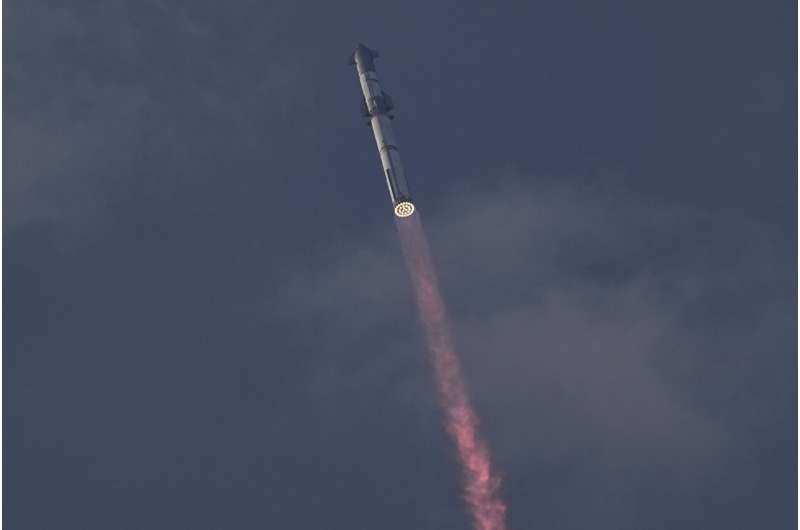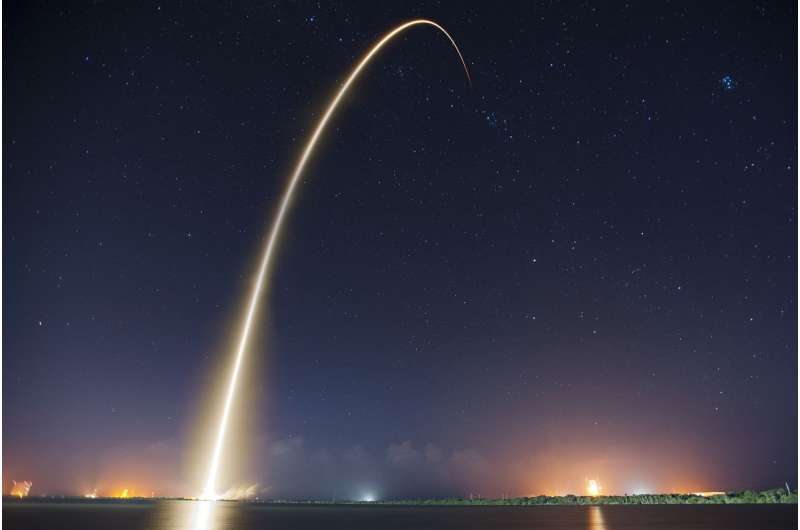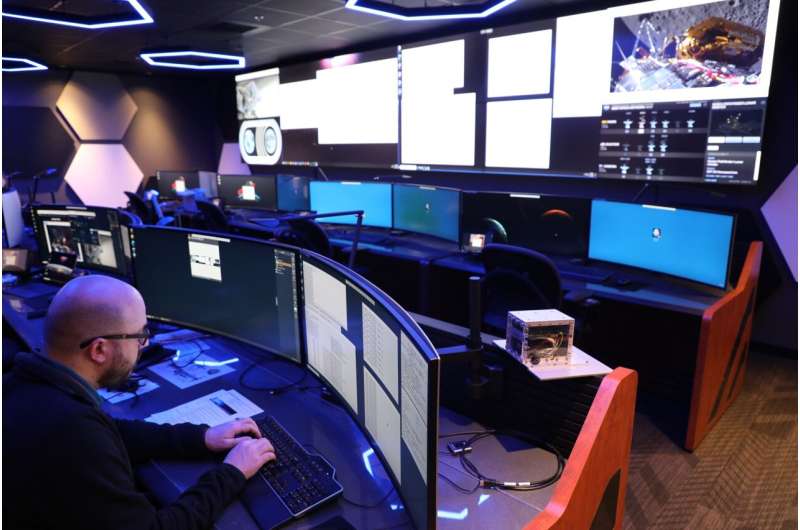Week in images: 11-15 March 2024
Friday, 15 March 2024 13:14
Week in images: 11-15 March 2024
Discover our week through the lens
Supporting rapid disaster response through space
Friday, 15 March 2024 08:20
ESA has launched a new partnership with industry through a project called SMART-CONNECT. The project aims to mitigate the challenges presented when traditional communication channels are disrupted during times of crisis, through facilitating the efficient and timely exchange of secure information between first responders and disaster control centres.
Earth from Space: Vienna, Austria
Friday, 15 March 2024 08:00 Image:
The historic centre of Vienna, Austria’s capital city, is featured in this image captured on 23 June 2023.
Image:
The historic centre of Vienna, Austria’s capital city, is featured in this image captured on 23 June 2023. SpaceX comes close to completing test flight of mega rocket but loses spacecraft near end
Friday, 15 March 2024 07:15
SpaceX came close to completing an hourlong test flight of its mega rocket on its third try Thursday, but the spacecraft was lost as it descended back to Earth.
The company said it lost contact with Starship as it neared its goal, a splashdown in the Indian Ocean. The first-stage booster also ended up in pieces, breaking apart much earlier in the flight over the Gulf of Mexico after launching from the southern tip of Texas near the Mexican border.
"The ship has been lost. So no splashdown today," said SpaceX's Dan Huot. "But again, it's incredible to see how much further we got this time around.
SpaceX's Starship mega rocket launches on third test flight
Thursday, 14 March 2024 23:07 The world's most powerful rocket Starship successfully blasted on its third test flight Thursday, in a live streamed event watched by two million people.
Lift-off from SpaceX's Starbase in southeast Texas came around 8:25 am local time (1325 GMT).
The mega rocket is vital to NASA's plans for landing astronauts on the Moon later this decade - and Elon Musk's hopes of eventually colon
The world's most powerful rocket Starship successfully blasted on its third test flight Thursday, in a live streamed event watched by two million people.
Lift-off from SpaceX's Starbase in southeast Texas came around 8:25 am local time (1325 GMT).
The mega rocket is vital to NASA's plans for landing astronauts on the Moon later this decade - and Elon Musk's hopes of eventually colon Reps. Chu and Bacon Spearhead Bipartisan Effort with Planetary Science Caucus Re-Launch
Thursday, 14 March 2024 23:07 In a significant stride towards bolstering space science and exploration, Representatives Judy Chu (CA-28) and Don Bacon (NE-02) have unveiled the re-establishment of the Planetary Science Caucus within the U.S. Congress.
This bipartisan initiative underscores the pivotal role of planetary science in fueling economic growth, enhancing national security, and cementing America's stature as a
In a significant stride towards bolstering space science and exploration, Representatives Judy Chu (CA-28) and Don Bacon (NE-02) have unveiled the re-establishment of the Planetary Science Caucus within the U.S. Congress.
This bipartisan initiative underscores the pivotal role of planetary science in fueling economic growth, enhancing national security, and cementing America's stature as a SpaceX's 3rd Starship launch makes it to space without exploding, but is lost on reentry
Thursday, 14 March 2024 19:11
SpaceX's powerful Starship and Super Heavy rocket completed a more successful third orbital test flight from Texas on Thursday morning with no explosive endings on the way up that marred the first two test flights in 2023.
The way down, though, still saw more destructive ends as the first-stage booster came in at more than 600 mph hitting the Gulf of Mexico and the upper stage spacecraft broke up on reentry halfway around the Earth. The overall mission, though, was considered a success by SpaceX officials.
"This is the furthest that we've gotten in our test flight, but the further we fly, the more data that we can get and that's ultimately the measure of success here," said SpaceX commentator and quality systems engineering manager Kate Tice. "I think today has been a huge success, given where we were, we'd gone, and how much further we've gotten with both the booster and Starship itself."
The Federal Aviation Administration announced late Wednesday it had granted SpaceX a license for the Orbital Flight Test 3, and the 396-foot-tall rocket took flight at 9:25 a.m.
NASA lights 'beacon' on moon with autonomous navigation system test
Thursday, 14 March 2024 17:51
SpaceX poised for third launch test of Starship megarocket
Thursday, 14 March 2024 17:23 SpaceX plans on Thursday to attempt another launch of Starship, the world's most powerful rocket that is vital to NASA's plans for landing astronauts on the Moon later this decade - and Elon Musk's hopes of eventually colonizing Mars.
Two previous attempts have ended in spectacular explosions, though that's not necessarily a bad thing: the company has adopted a rapid trial-and-error approac
SpaceX plans on Thursday to attempt another launch of Starship, the world's most powerful rocket that is vital to NASA's plans for landing astronauts on the Moon later this decade - and Elon Musk's hopes of eventually colonizing Mars.
Two previous attempts have ended in spectacular explosions, though that's not necessarily a bad thing: the company has adopted a rapid trial-and-error approac China Advances on Reusable Rocket Technology with Launches Planned for 2025 and 2026
Thursday, 14 March 2024 17:23 In a significant move towards sustainable space exploration, China is fast-tracking the development of two large reusable rockets, with diameters of 4 meters and 5 meters, slated for their first launches in 2025 and 2026, respectively.
This initiative by the China Aerospace Science and Technology Corporation marks a pivotal response to the burgeoning demand within the commercial space sect
In a significant move towards sustainable space exploration, China is fast-tracking the development of two large reusable rockets, with diameters of 4 meters and 5 meters, slated for their first launches in 2025 and 2026, respectively.
This initiative by the China Aerospace Science and Technology Corporation marks a pivotal response to the burgeoning demand within the commercial space sect Final Mission: Delta IV Heavy Rocket Set for Historic Launch with NROL-70 Payload
Thursday, 14 March 2024 17:23 The Space Systems Command (SSC) of the U.S. Space Force, in partnership with the National Reconnaissance Office (NRO) and United Launch Alliance (ULA), has announced the scheduled launch of the NROL-70 mission. This event, set for no earlier than March 28, will mark the final flight of the Delta IV Heavy rocket. The launch is planned from Space Launch Complex-37B at Cape Canaveral Space Force St
The Space Systems Command (SSC) of the U.S. Space Force, in partnership with the National Reconnaissance Office (NRO) and United Launch Alliance (ULA), has announced the scheduled launch of the NROL-70 mission. This event, set for no earlier than March 28, will mark the final flight of the Delta IV Heavy rocket. The launch is planned from Space Launch Complex-37B at Cape Canaveral Space Force St NASA Allocates DALI Grants to Foster Lunar Science and Exploration Innovations
Thursday, 14 March 2024 17:23Protect Earth instead of colonising Mars, Obama says
Thursday, 14 March 2024 17:23 Humanity must preserve Earth before dreaming of colonising Mars because even nuclear war and unbridled climate change cannot make the red planet more liveable, Barack Obama said Wednesday.
Speaking at a renewable energy conference in the French capital Paris, the former US president mentioned Silicon Valley "tycoons, many of whom are building spaceships" that could take humans to Mars.
"
Humanity must preserve Earth before dreaming of colonising Mars because even nuclear war and unbridled climate change cannot make the red planet more liveable, Barack Obama said Wednesday.
Speaking at a renewable energy conference in the French capital Paris, the former US president mentioned Silicon Valley "tycoons, many of whom are building spaceships" that could take humans to Mars.
" SwRI receives $2 million NASA grant to develop lunar-regolith-measuring instrument
Thursday, 14 March 2024 17:23 Southwest Research Institute (SwRI) has been awarded a three-year, $2,041,000 grant from NASA's Development and Advancement of Lunar Instrumentation (DALI) program to further develop a novel ground-penetrating radar instrument. The Synthetic Pulse Artemis Radar for Crustal Imaging (SPARCI, pronounced "sparky") instrument is designed to characterize the depth of the regolith and upper megaregolit
Southwest Research Institute (SwRI) has been awarded a three-year, $2,041,000 grant from NASA's Development and Advancement of Lunar Instrumentation (DALI) program to further develop a novel ground-penetrating radar instrument. The Synthetic Pulse Artemis Radar for Crustal Imaging (SPARCI, pronounced "sparky") instrument is designed to characterize the depth of the regolith and upper megaregolit 

 Image:
Laser light sabre
Image:
Laser light sabre